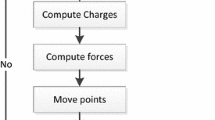Abstract
In wireless mesh networks (WMNs) the meshing architecture, consisting of a grid of mesh routers, provides connectivity services to mesh client nodes. The performance and operability of WMNs largely depends on placement of mesh routers nodes in the geographical area to achieve network connectivity and stability. Thus, finding optimal or near-optimal mesh router nodes placement is crucial to such networks. In this work we propose and evaluate genetic algorithms (GAs) for near-optimally solving the problem. In our approach we seek a two-fold optimization, namely, the maximization of the size of the giant component in the network and the user coverage. The size of the giant component is considered here as a criteria for measuring network connectivity and user coverage as QoS. GAs explore the solution space by means of a population of individuals, which are evaluated, selected, crossed and mutated to reproduce new individuals of better quality. The fitness of individuals is measured with respect to network connectivity and user coverage being the former a primary objective and the later a secondary one. Several genetic operators have been considered in implementing GAs in order to find the configuration that works best for the problem. We have experimentally evaluated the proposed GAs using a benchmark of generated instances varying from small to large size. In order to evaluate the quality of achieved solutions for different possible client distributions, instances have been generated using four distributions of mesh clients (Uniform, Normal, Exponential and Weibull). The experimental results showed the efficiency of the GAs for computing high quality solutions of mesh router nodes placement in WMNs.












Similar content being viewed by others

Notes
In the literature, instances having up to 60 mesh devices are usually considered realistic-size instances.
References
Akyildiz IF, Wang X, Wang W (2005) Wireless mesh networks: a survey. Comput Netw 47(4):445–487
Amaldi E, Capone A, Cesana M, Filippini I, Malucelli F (2008) Optimization models and methods for planning wireless mesh networks. Comput Netw 52:2159–2171
Antony Franklin A, Siva Ram Murthy C (2007) Node placement algorithm for deployment of two-tier wireless mesh networks. In: Proceedings of IEEE GLOBECOM 2007, IEEE global communications conference, pp 4823–4827
Chen C, Chekuri C (2007) Urban wireless mesh network planning: the case of directional antennas. Tech report no. UIUCDCS-R-2007-2874. Department of Computer Science, University of Illinois at Urbana-Champaign
Garey MR, Johnson DS (1979) Computers and intractability—a guide to the theory of NP-completeness. Freeman, San Francisco
Holland J (1975) Adaptation in natural and artificial systems. University of Michigan Press, Ann Arbor
Lim A, Rodrigues B, Wang F, Xua Zh (2005) k-Center problems with minimum coverage. Theor Comput Sci 332:1–17
Muthaiah SN, Rosenberg C (2008) Single gateway placement in wireless mesh networks. In: Proceedings of 8th international IEEE symposium on computer networks, Turkey
Nandiraju N, Nandiraju D, Santhanama L, He B, Wang J, Agrawal D (2007) Wireless mesh networks: current challenges and future direction of web-in-the-sky. : IEEE Wirel Commun 14(4):79–89
Tang M (2009) Gateways placement in backbone wireless mesh networks. Int J Commun Netw Syst Sci 1:1–89
Vanhatupa T, Hännikäinen M, Hämäläinen TD (2007) Genetic algorithm to optimize node placement and configuration for WLAN planning. In: Proceedings of 4th international symposium on wireless communication systems, pp 612–616
Wang J, Xie B, Cai K, Agrawal DP (2007) Efficient mesh router placement in wireless mesh networks. In: Proceedings of IEEE MASS’07, pp 1–9
Xhafa F, Sanchez C, Barolli L (2009) Ad hoc and neighborhood search methods for placement of mesh routers in wireless mesh networks. In: Proceedings of ICDCS workshops of the IEEE 29th international conference on distributed computing systems (ICDCS’09), pp 400–405
Zhou P, Manoj BS, Rao R (2007) A gateway placement algorithm in wireless mesh networks. In: Proceedings of the 3rd international conference on wireless internet (Austin, Texas, October 22–24, 2007). ICST (Institute for Computer Sciences Social-Informatics and Telecommunications Engineering), Brussels, pp 1–9
Acknowledgments
Fatos Xhafa’s research work partially done at Birkbeck, University of London, on leave from Technical University of Catalonia (Barcelona, Spain). His research is supported by General Secretariat of Universities of the Ministry of Education, Spain.
Author information
Authors and Affiliations
Corresponding author
Rights and permissions
About this article
Cite this article
Xhafa, F., Sanchez, C., Barolli, L. et al. Evaluation of genetic algorithms for mesh router nodes placement in wireless mesh networks. J Ambient Intell Human Comput 1, 271–282 (2010). https://doi.org/10.1007/s12652-010-0022-2
Received:
Accepted:
Published:
Issue Date:
DOI: https://doi.org/10.1007/s12652-010-0022-2



